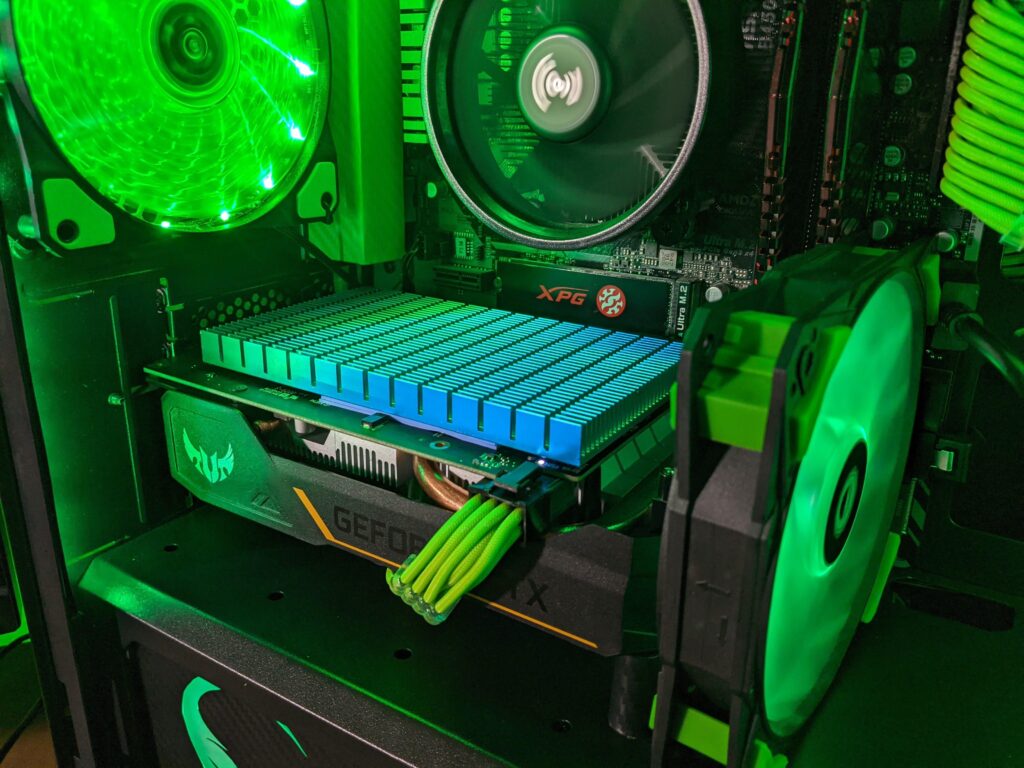If you’ve ever looked at a modern graphics card, you may have noticed a sleek metal or plastic plate covering the back side of the GPU. That’s called a GPU backplate — a simple feature that’s often misunderstood or overlooked.
But is it just for looks, or does it actually serve a purpose? In this guide, we’ll break down everything you need to know about GPU backplates, including their benefits, types, and whether or not you really need one for your gaming or workstation PC.
A GPU backplate is a rigid plate mounted on the rear side of a graphics card. It’s usually made from metal (like aluminum) or strong plastic and is attached directly to the PCB (Printed Circuit Board) of the GPU.
At first glance, a backplate may look purely cosmetic, but it actually serves several useful functions.

One of the main reasons manufacturers include backplates is to make the GPU look cleaner and more premium, especially in open or windowed PC cases. A stylish backplate can complement your build’s color scheme and theme.
Modern GPUs are getting larger and heavier. A backplate adds rigidity and helps prevent GPU sag, which can occur when the weight of the cooler pulls down on the PCIe slot over time.
Some backplates are designed to act as passive heat spreaders. Metal backplates can absorb and dissipate a small amount of heat from the PCB or memory chips. Some even include thermal pads to improve contact with hot components.
⚠️ Note: Not all backplates help with cooling — some plastic ones are purely decorative.
A backplate helps shield delicate circuits, capacitors, and solder points from dust, accidental bumps, or static discharge when installing or handling the card.
- Metal Backplates (Aluminum or Steel)
- Most effective for passive heat dissipation.
- Common in mid-range to high-end GPUs.
- Most effective for passive heat dissipation.
- Plastic Backplates
- Primarily used for looks and light protection.
- Found in budget or entry-level GPUs.
- Primarily used for looks and light protection.
- RGB or Custom Backplates
- Includes RGB lighting or custom designs.
- Popular in high-end gaming and showcase builds.
- Includes RGB lighting or custom designs.

While a GPU can function perfectly fine without a backplate, having one offers several advantages, especially in premium or enthusiast builds.
You should consider a GPU with a backplate if:
- You want a clean, professional look inside your case.
- Your GPU is large and might sag without extra support.
- Your build focuses on aesthetics or uses a vertical GPU mount.
- You want minor extra cooling or passive protection.
However, if you’re on a budget or buying a lower-end graphics card, a backplate isn’t essential and won’t impact actual gaming performance.
Yes, there are aftermarket GPU backplates available that are compatible with certain GPU models. You can also 3D print or custom order one to match your setup. Just make sure:
- It’s compatible with your exact GPU model.
- It doesn’t block any airflow or connectors.
- It doesn’t short out any components (use proper insulation).
| Pros | Cons |
| Improves appearance | May slightly raise GPU temps (in rare cases) |
| Adds structural strength | Not always effective for cooling |
| Protects sensitive PCB areas | Adds a bit of weight to the GPU |
| May provide passive cooling | Adds slight cost to GPU pricing |
No, GPU backplates don’t increase gaming performance or FPS. Their benefits are mostly structural and aesthetic.
Some metal backplates help slightly with passive heat dissipation, especially if they include thermal pads. However, they are not a replacement for proper cooling.
Absolutely. A backplate is not required for a GPU to function safely or properly.
Yes, it adds structural rigidity and helps support the weight of the graphics card, especially when combined with a GPU support bracket.
Yes, many aftermarket options exist for RGB and custom-themed backplates, but make sure they are designed for your exact GPU model.
A GPU backplate is not a must-have, but it can definitely be a nice-to-have feature for those who care about aesthetics, airflow, and the longevity of their graphics card. It won’t affect your FPS, but it will make your build look cleaner, and in some cases, it can even help with durability and thermal performance. If you’re building a PC with a side window or want to keep your GPU well-supported, choosing a graphics card with a backplate is a smart move.
- Vertical Mount Gpu – The Ultimate Guide to Aesthetic and Efficient GPU Setup!
- Noctua Gpu – The Ultimate Silent Cooling Solution for Graphics Cards!
- How To OverClock Your Gpu – A Complete Beginner’s Guide!
